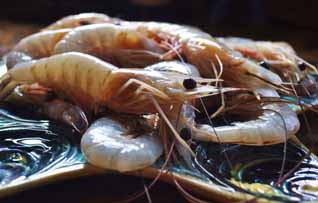 rimp producers are facing a dilemma over stocking levels, as they try to increase production to cash in on increased demand and prices — while at the same time protecting stocks from early mortality syndrome (EMS), seafoodsource reports.
rimp producers are facing a dilemma over stocking levels, as they try to increase production to cash in on increased demand and prices — while at the same time protecting stocks from early mortality syndrome (EMS), seafoodsource reports.“We could increase volumes by 50 to 60 percent, but to do that we’d have to increase stocking densities and thus the risk of disease,” said Sutanto Surjadjaja, managing director of CP Prima, an Indonesian arm of the CP conglomerate.
Surjadjaja said that his firm hopes next year to get production up to 42,000 metric tons (MT) — up from the 36,000 MT expected in 2013. “It’s a difficult call we have to make, between risk and gain.” Average stocking levels in Indonesia are similar to those in other Southeast Asian states like Thailand but CP Prima made a company decision to limit stocking levels in order to prevent disease, explained Surjadjaja.
Shrimp prices have increased two fold in the past year he explained, creating a dilemma for CP Prima, which operates the world’s largest shrimp farm and has supply contracts with independent farmers. The CP Prima boss expects shrimp prices to stay solid in 2014 due to the lingering effects of EMS. “Even if there is a rebound in shrimp production it will take a long time for the price to slip back because there is no quick solution to EMS.”
Sutanto Surjadjaja believes the shrimp sector in Southeast Asia faces some hard choices. A solution to the EMS crisis requires time and will force producers to decide if they’re willing to invest the required time and the funds in infrastructure to prevent EMS…or they’ll have to exit the sector.”
A growing market, China — which like Thailand has been hit by EMS — remains desperate for supply and has been paying over the odds for supply from Ecuador, he noted. Growing China demand puts Indonesia in a strong position, said Surjadjaja, given shrimp supplies from alternative suppliers like Malaysian are lower in quantity.
More than half of CP Prima’s sales are currently in the U.S., with 25 percent going to the EU and 20 percent to Japan. CP Prima is looking to build sales in China but is keen to sell value added products that it launched last year to capitalize on economic growth in its domestic Indonesian market. To protect its margins Jakarta-based CP Prima (also known as PT Central Proteinaprima Tbk or CPRO) CP Prima in 2012 launched five processed shrimp product such as ebi fry, shrimp cutlets, shrimp rolls and shrimp nuggets.
Scale and its integrated business model are both key to CP Prima’s success, said Surjadjaja. Unlike most smaller-sized peers CP Prima is one of a few fully integrated shrimp firms in Indonesia. The business model helps the firm to secure western certification and higher end clients for its products. “Achieving any of the certification programs is easier since we run our own feed mill as well as farming and processing operations,” he added. “We are not targeting the mass market, we are seeking the premium market.”





